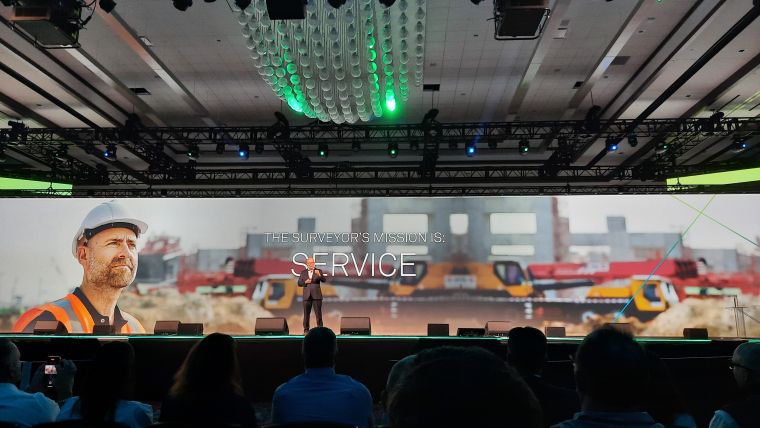Reflections on HxGN LIVE Global 2023
Service in the surveying industry
It is time to innovate with technology that can be applied ‘right here, right now’. That was the clear message during HxGN LIVE Global 2023. President and CEO Paolo Guglielmini set the tone with his opening keynote speech on ‘Optimism at scale: The power of you, technology and community’. Which new geospatial technology was showcased? How does Hexagon envision that this can be instrumental for solving the world’s sustainability challenges? And why does our industry need to ‘put the serve in surveying’? Here, GIM International presents some of the key takeaways.
This year’s edition of Hexagon’s flagship event, the HxGN LIVE Global 2023 conference, was held in the US city of Las Vegas, Nevada, from 12-15 June. More than 3,600 people from 77 countries around the world attended this high-profile showcase of the latest Hexagon technology and applications. The event was also an important information and networking hub for professionals wanting to gain a glimpse of upcoming developments in terms of geospatial sensors, software and autonomous technology, and to learn more about potential future applications.
Supported by stunning audiovisuals, passionate Hexagon executives shared their company’s vision. With a focus on “optimism at scale” (Paolo Guglielmini, president and CEO), the message was clear: it is time to innovate – and not just sometime in the future, but with technology that can be applied “right here, right now” (Burkhard Boeckem, CTO).
Capturing reality across Hexagon’s industries
In his keynote session on ‘Optimism at scale’, Paolo Guglielmini highlighted the company’s focus on creating the right technology for the Hexagon user communities while achieving opportunities for them at scale. He emphasized human-centric innovation, in which the applicability to users’ needs, technology usability and flexibility in business models is key.
Digital manufacturing for the automotive industry is one inspiring use case demonstrating how Hexagon’s reality capture technology is being used today. Californian-based engineering company Divergent utilizes advanced CAD design software, AI/ML software models for quality optimization, and 3D printing and assembly technology to build digital production lines for printed car parts. Digitizing the production process reduces the need for parts and also for energy, plus all the components can be recycled for future use.
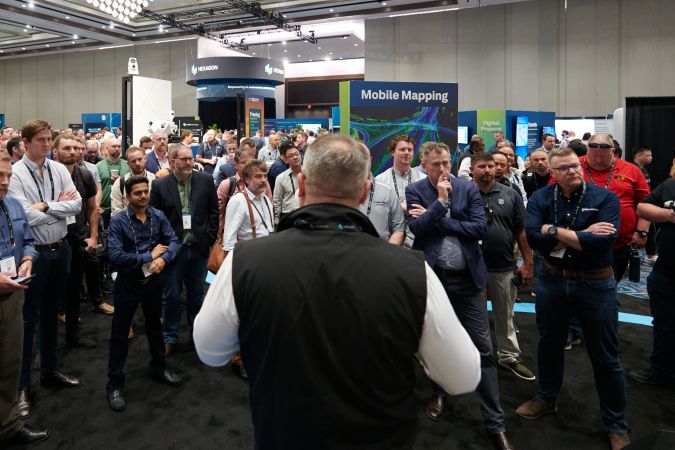
A second highlighted example was in the construction sector, where US-based Mortensen uses digital construction techniques for constructing modular hotels using reality capture and autonomous technology. Thanks to drone flights, photo documentation, real-time progress updates and the use of robotics for the layout of construction elements, construction projects are completed faster and more efficiently using fewer materials. The construction process is also much safer because there is less on-site construction work at height.
Industries are racing to digitize their physical processes, and artificial intelligence (AI), virtual reality (VR) and the metaverse will become increasingly important. Hexagon has intensified its collaboration with NVIDIA, a pioneer in accelerated computing, to combine Hexagon’s reality capture expertise with NVIDIA’s expertise in AI, VR and visualization. Thanks to this strengthened relationship, industrial and construction processes can be AI-optimized using NVIDIA’s virtual worlds. To enable future steps in AI, machine learning (ML) and automation for all Hexagon industries, the company will also connect its Hexagon Digital Reality (HxDR) and NEXUS software suites to NVIDIA’s Omniverse.
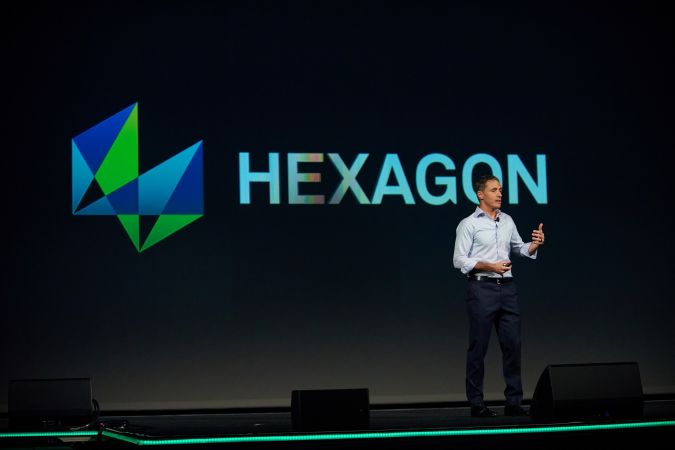
Innovation in everything: right here, right now
Hexagon’s CTO Burkhard Boeckem presented the latest technological developments that are available right here, right now. At the heart of Hexagon’s innovation thinking is the belief that industrial technologies need to be as human-centric as consumer technologies. Therefore, all new Hexagon innovations need to be intuitive, efficient and inspiring for any industry and any application, he explained.
Some examples of that human-centric approach include the highly intuitive BLK360 laser scanner that was launched at HxGN LIVE 2022, the improved tilt function of the Leica AP20 autopole that has made creating survey points much more intuitive, and the new single-person-use car mount for the Leica Pegasus RTK mobile mapper.
The new HxDR solutions make it possible to process and share digital realities at any scale. This facilitates the visualization of entire cities and environmental simulations with custom industry solutions. Moreover, surveyors can connect Hexagon products to digital twins in the cloud and create new applications powered by HxDR. For example, 2D and 3D subsurface models can be generated from ground penetrating radar data without additional coding.
For surveying and mapping applications, the most promising development powered by HxDR is Reality Cloud Studio. Essential reality capture data visualization, collaboration and storage functionalities are made available in a web browser at an accessible price point. This makes it very easy for users to upload their data and provide all project members with access to survey-grade mapping and 3D visualization.
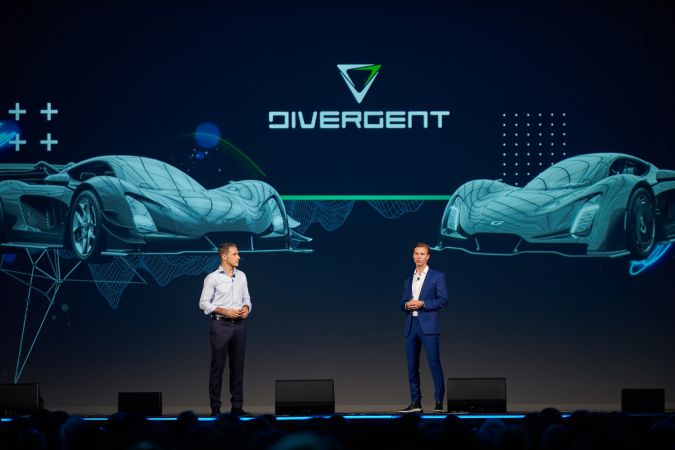
Putting the serve in surveying
Morritz Lauwiner, president of the firm’s geomatics division, addressed the changing landscape for surveyors in his keynote on ‘Putting the serve in surveying’. Surveyors are at the core of the surveying profession and need to provide accuracy, quality, reliability, client satisfaction and a professional reputation, he stated. Lauwiner’s main message was that the major technological advancements mean that surveyors need to innovate. But their innovation efforts should go beyond investing in new technology such as accurate sensors and intelligent software. For surveyors, innovation also means that they need to add value by investing in their service level. After all, surveyors are in the service business; they should be not only selling their expertise, but also converting it into a superior service for their end users.
Doug Browning, a surveyor at the US firm Walsh Construction & Archer Western, presented a very informative use case to illustrate this. Besides high-quality survey data and deliverables, his company also strives to deliver a superior service by focusing on communication and teamwork, being able to work with different technologies and processes, attention to detail, flexibility, adaptability and availability.
A second example of the added value of technology came from Derek Twente, geospatial service manager at TWM Inc, an engineering firm in the St. Louis region. He explained that new technology improves his current services because new features enable him to better serve client needs and also help him to capture more data with fewer people. As technology is becoming more accessible, the technological playing field is levelling out, according to Twente. It will therefore become increasingly important for surveyors to set themselves apart by focusing on other aspects like improving their service level and other business skills.
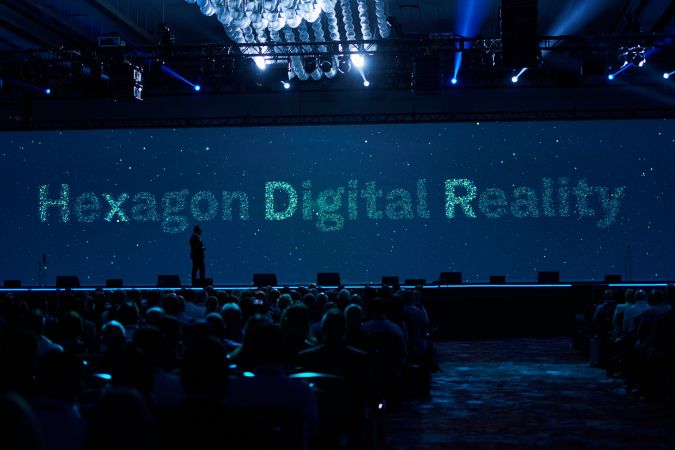
Sustainability through sustainable business models
At Hexagon, they are very passionate about sustainability and strongly believe that the technology they create is instrumental for solving sustainability challenges. In key Hexagon business sectors such as construction, industrial facilities and 3D printing, business goals and decarbonization targets go hand in hand. There are multiple examples, including reducing the use of building materials, reducing waste and designing new industrial manufacturing products with recycling or reuse in mind.
In fact, Hexagon has a separate business division called R-Evolution focusing specifically on sustainability, which is seen as one of the biggest business opportunities for the 21st century. R-Evolution’s mission is to accelerate green technology across the world. One example is the project on which research organization Beneath The Waves cooperated with R-Evolution in the Bahamas. According to seafloor sediment research, seagrass captures 10-15 times more carbon than tropical rainforests, and 35 times faster. Using Hexagon’s airborne Lidar solutions, Beneath The Waves was able to measure how much CO2 was stored in the seagrass and sediment in the Bahamas seagrass meadows. The most important discovery is that the Bahamas is potentially the largest nature-based carbon capture reservoir (92km2) in the world. This example illustrates that nature can be an asset in achieving sustainability goals.
R-Evolution is also working on a sustainable business model in forestry conservation and protecting biodiversity, with research outcomes expected to be available next year. It is hoped that these initiatives will help to build a sustainable business model for similar nature conservation projects around the world.
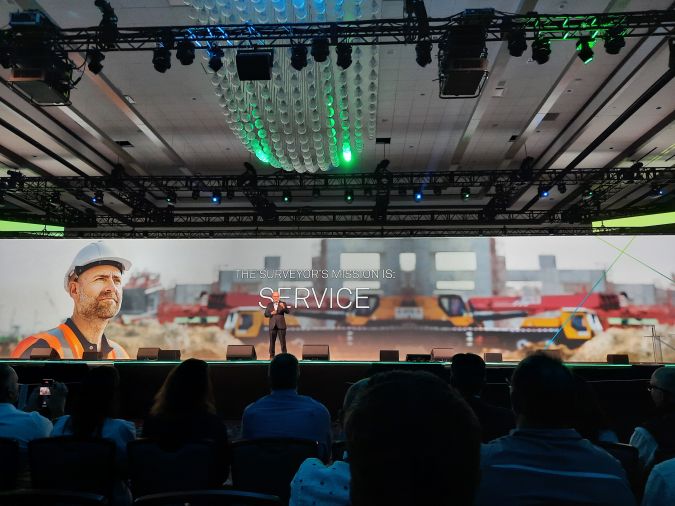
Other new launches and announcements
Leica Geosystems has launched the brand-new Leica CountryMapper for large-area imaging and Lidar mapping. By integrating a large-format photogrammetric camera and a high-performance Lidar unit into a single system, the CountryMapper enables the simultaneous collection of foundational geospatial data, resulting in the generation of highly accurate data products to support a wide range of customer applications.
The BLK2GO PULSE, which is planned for release in early 2024, will add a new, unique and disruptive member to the BLK2GO product family. The handheld reality capture device fuses Sony’s advanced time-of-flight technology and Hexagon’s GrandSLAM technology to create a fast, simple and intuitive first-person scanning method for mapping from your point of view. It will be primarily used for short-range indoor applications with instant point cloud visualization while you capture.
3 takeaways for the surveying community
Hexagon is building AI solutions and industrial metaverses, and is investing heavily in robotics. Converting digital reality data into land cover layers, classifying models, modelling 3D environments and buildings, detecting changes and managing construction processes are just some of the things that AI can already do. But what does this mean for surveyors? How can they leverage technology to add value? And how can they compete in a landscape in which technology can replace some tasks to a certain extent? These three takeaways from HxGN LIVE 2023 should provide pointers for the surveying community:
- The technology is already available, including use cases. More accurate sensors and intelligent software solutions are being developed all the time. It is crucial to keep pace with the technological advancements.
- Focus on developing your market position. Surveyors need to focus on the needs of their main group of customers and users. Adopt technology that strengthens your unique value proposition based on your main surveying applications.
- To serve is at the heart of the surveyor, and new technology will not change this. Besides adopting technology, surveyors need to maintain and improve their service level.
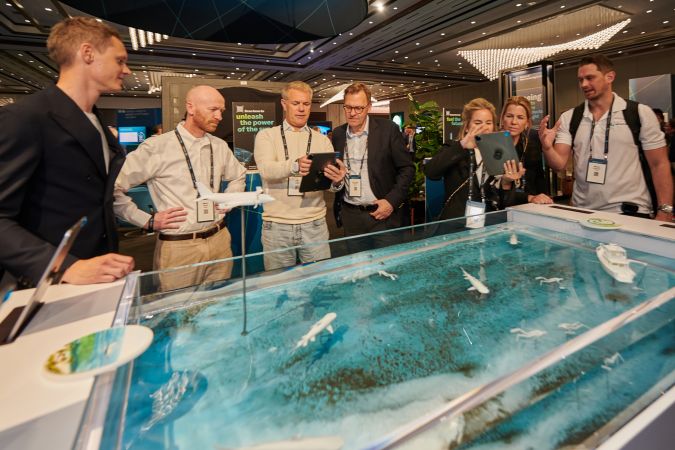

Value staying current with geomatics?
Stay on the map with our expertly curated newsletters.
We provide educational insights, industry updates, and inspiring stories to help you learn, grow, and reach your full potential in your field. Don't miss out - subscribe today and ensure you're always informed, educated, and inspired.
Choose your newsletter(s)
